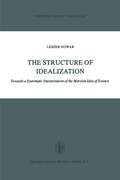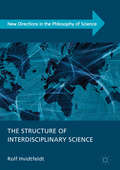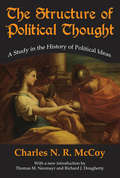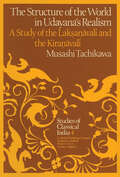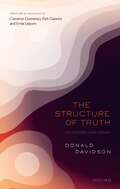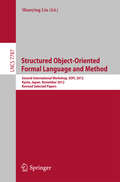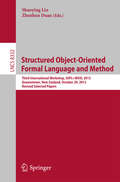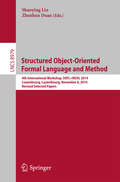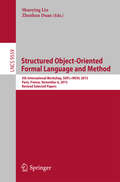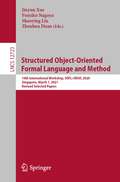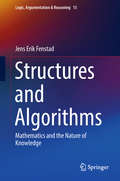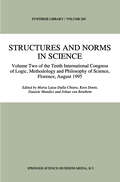- Table View
- List View
The Structure of Idealization: Towards a Systematic Interpretation of the Marxian Idea of Science (Synthese Library #139)
by Lesz NowakMuch is said in Marxist literature about Marxist methodology which is supposed to be entirely original - differing a great deal from all other trends in the modern philosophy of science. On the other hand, however, it is unfallacious to state that there are no people outside Marxism who would like to deny this statement. This has to put those who really believe that Marxism has something important to say in philosophy of science on guard: if someone says something important others usually are inclined to protest. But who is inclined to protest when it is stated that Marx em ployed both induction and deduction, a historical method and a logical one as well, synthesis, but also analysis, etc? Who is inclined to protest when it is not known what within this framework 'induction', 'deduction' 'history' or 'logic' mean? Who is inclined to protest when 'Marxist meth odology' is presented not with the aid of precise definitions and clear hypotheses but with the aid of a jungle of quotations? I think that the main malfeasance of the current 'Marxist methodology', is that of ecclecticism. The methodology of Marx is presented as a col lection of trivial and/or obscure ideas but not as a system of statements subordinated to any clear, definite viewpoint presenting a new grasp ofthe nature of scientific cognition. Search for reconstruction of Marxian meth odology as a system of the kind is the main aim of this book.
The Structure of Interdisciplinary Science (New Directions in the Philosophy of Science)
by Rolf HvidtfeldtThis book presents a novel approach to the analysis of interdisciplinary science based on the contemporary philosophical literature on scientific representation. The basic motivation for developing this approach is that epistemic issues are insufficiently dealt with in the existing literature on interdisciplinarity. This means that when interdisciplinary science is praised (as it often is), it is far from clear to what extent this praise is merited – at least if one cares about various more or less standardised measures of scientific quality. To develop a more adequate way of capturing what is going on in interdisciplinary science, the author draws inspiration from the rich philosophical literature on modelling, idealisation, perspectivism, and scientific pluralism. The discussion hereof reveals a number of critical pitfalls related to transferring mathematical and conceptual tools between scientific contexts, which should be relevant and interesting for anyone actively engaged in funding, evaluating, or carrying out interdisciplinary science.
The Structure of Interdisciplinary Science (New Directions in the Philosophy of Science)
by Rolf HvidtfeldtThis book presents a novel approach to the analysis of interdisciplinary science based on the contemporary philosophical literature on scientific representation. The basic motivation for developing this approach is that epistemic issues are insufficiently dealt with in the existing literature on interdisciplinarity. This means that when interdisciplinary science is praised (as it often is), it is far from clear to what extent this praise is merited – at least if one cares about various more or less standardised measures of scientific quality. To develop a more adequate way of capturing what is going on in interdisciplinary science, the author draws inspiration from the rich philosophical literature on modelling, idealisation, perspectivism, and scientific pluralism. The discussion hereof reveals a number of critical pitfalls related to transferring mathematical and conceptual tools between scientific contexts, which should be relevant and interesting for anyone actively engaged in funding, evaluating, or carrying out interdisciplinary science.
The Structure of Liberty: Justice and the Rule of Law
by Randy E. BarnettIn this book, legal scholar Randy Barnett elaborates and defends the fundamental premise of the Declaration of Independence: that all persons have a natural right to pursue happiness so long as they respect the equal rights of others, and that governments are only justly established to secure these rights. Drawing upon insights from philosophy, economics, political theory, and law, Barnett explains why, when people pursue happiness while living in society with each other, they confront the pervasive social problems of knowledge, interest and power. These problems are best dealt with by ensuring the liberty of the people to pursue their own ends, but this liberty is distinguished from "license" by certain fundamental rights and procedures associated with the classical liberal conception of "justice" and "the rule of law." He then outlines the constitutional framework that is needed to put these principles into practice. In a new Afterword to this second edition, Barnett elaborates on this thesis by responding to several important criticisms of the original work. He then explains how this "libertarian" approach is more modest than either the "social justice" theories of the left or the "legal moralism" of the right.
The Structure of Perceptual Experience (Ratio Special Issues)
by James StazickerThis innovative new collection features six original essays exploring the spatial, temporal, and other structures that shape conscious perception. Includes cutting-edge research on an increasingly influential topic in the philosophy of the mind Explores structural differences between the senses and between different theories of perceptual experience Offers innovative new arguments on the philosophy of perception written by leading scholars in the field
The Structure of Perceptual Experience (Ratio Special Issues)
by James StazickerThis innovative new collection features six original essays exploring the spatial, temporal, and other structures that shape conscious perception. Includes cutting-edge research on an increasingly influential topic in the philosophy of the mind Explores structural differences between the senses and between different theories of perceptual experience Offers innovative new arguments on the philosophy of perception written by leading scholars in the field
The Structure of Physics (Fundamental Theories of Physics #155)
by Carl F. WeizsäckerThe book is a newly arranged and revised English version of "Aufbau der Physik" by Carl Friedrich von Weizsäcker. Some original chapters and sections have been deleted, and a new chapter about further insights and results of ur-theoretic research of the late 1980’s and 1990’s has been included. Carl Friedrich von Weizsäcker combines the perspectives of science, philosophy, religion and politics with a view towards the challenges as well as the responsibilities of our time.
The Structure of Political Thought: A Study in the History of Political Ideas
by Charles N. McCoyOriginally published in 1963, this classic book is a rethinking of the history of Western political philosophy. Charles N. R. McCoy contrasts classical-medieval principles against the "hypotheses" at the root of modern liberalism and modern conservativism.In Part I, "The Classical Christian Tradition from Plato to Aquinas," the author lays the foundation for a philosophical "structure" capable of producing "constitutional liberty." Part II, "The Modern Theory of Politics from Machiavelli to Marx," attempts to show, beginning with Machiavelli, the reversal and destruction of the pre-modern "structure" postulated in Part I.McCoy stresses the great contributions of Aristotle to political thought found in his more familiar Ethics and Politics, but also includes key insights drawn from Metaphysics and Physics. These contributions are developed and perfected, McCoy argues, by Augustine and Aquinas. Two other important features include McCoy's epistemological insights into Plato's work that will be new to many readers and the author's juxtaposition of traditional natural law with "the modernized theory of natural law." The modern account of autonomous natural law, in McCoy's view, helps explain the totalitarian direction of key aspects of modern political thought. This classic volume on the origins of modern philosophical thought remains a standard in the field.
The Structure of Political Thought: A Study in the History of Political Ideas (The\library Of Conservative Thought Ser.)
by Charles N. McCoyOriginally published in 1963, this classic book is a rethinking of the history of Western political philosophy. Charles N. R. McCoy contrasts classical-medieval principles against the "hypotheses" at the root of modern liberalism and modern conservativism.In Part I, "The Classical Christian Tradition from Plato to Aquinas," the author lays the foundation for a philosophical "structure" capable of producing "constitutional liberty." Part II, "The Modern Theory of Politics from Machiavelli to Marx," attempts to show, beginning with Machiavelli, the reversal and destruction of the pre-modern "structure" postulated in Part I.McCoy stresses the great contributions of Aristotle to political thought found in his more familiar Ethics and Politics, but also includes key insights drawn from Metaphysics and Physics. These contributions are developed and perfected, McCoy argues, by Augustine and Aquinas. Two other important features include McCoy's epistemological insights into Plato's work that will be new to many readers and the author's juxtaposition of traditional natural law with "the modernized theory of natural law." The modern account of autonomous natural law, in McCoy's view, helps explain the totalitarian direction of key aspects of modern political thought. This classic volume on the origins of modern philosophical thought remains a standard in the field.
The Structure of Scientific Revolutions: 50th Anniversary Edition
by Thomas S. KuhnA good book may have the power to change the way we see the world, but a great book actually becomes part of our daily consciousness, pervading our thinking to the point that we take it for granted, and we forget how provocative and challenging its ideas once were—and still are. The Structure of Scientific Revolutions is that kind of book. When it was first published in 1962, it was a landmark event in the history and philosophy of science. Fifty years later, it still has many lessons to teach. With The Structure of Scientific Revolutions, Kuhn challenged long-standing linear notions of scientific progress, arguing that transformative ideas don’t arise from the day-to-day, gradual process of experimentation and data accumulation but that the revolutions in science, those breakthrough moments that disrupt accepted thinking and offer unanticipated ideas, occur outside of “normal science,” as he called it. Though Kuhn was writing when physics ruled the sciences, his ideas on how scientific revolutions bring order to the anomalies that amass over time in research experiments are still instructive in our biotech age. This new edition of Kuhn’s essential work in the history of science includes an insightful introduction by Ian Hacking, which clarifies terms popularized by Kuhn, including paradigm and incommensurability, and applies Kuhn’s ideas to the science of today. Usefully keyed to the separate sections of the book, Hacking’s introduction provides important background information as well as a contemporary context. Newly designed, with an expanded index, this edition will be eagerly welcomed by the next generation of readers seeking to understand the history of our perspectives on science.
The Structure of Scientific Revolutions: 50th Anniversary Edition
by Thomas S. KuhnA good book may have the power to change the way we see the world, but a great book actually becomes part of our daily consciousness, pervading our thinking to the point that we take it for granted, and we forget how provocative and challenging its ideas once were—and still are. The Structure of Scientific Revolutions is that kind of book. When it was first published in 1962, it was a landmark event in the history and philosophy of science. Fifty years later, it still has many lessons to teach. With The Structure of Scientific Revolutions, Kuhn challenged long-standing linear notions of scientific progress, arguing that transformative ideas don’t arise from the day-to-day, gradual process of experimentation and data accumulation but that the revolutions in science, those breakthrough moments that disrupt accepted thinking and offer unanticipated ideas, occur outside of “normal science,” as he called it. Though Kuhn was writing when physics ruled the sciences, his ideas on how scientific revolutions bring order to the anomalies that amass over time in research experiments are still instructive in our biotech age. This new edition of Kuhn’s essential work in the history of science includes an insightful introduction by Ian Hacking, which clarifies terms popularized by Kuhn, including paradigm and incommensurability, and applies Kuhn’s ideas to the science of today. Usefully keyed to the separate sections of the book, Hacking’s introduction provides important background information as well as a contemporary context. Newly designed, with an expanded index, this edition will be eagerly welcomed by the next generation of readers seeking to understand the history of our perspectives on science.
The Structure of Scientific Revolutions: 50th Anniversary Edition
by Thomas S. KuhnA good book may have the power to change the way we see the world, but a great book actually becomes part of our daily consciousness, pervading our thinking to the point that we take it for granted, and we forget how provocative and challenging its ideas once were—and still are. The Structure of Scientific Revolutions is that kind of book. When it was first published in 1962, it was a landmark event in the history and philosophy of science. Fifty years later, it still has many lessons to teach. With The Structure of Scientific Revolutions, Kuhn challenged long-standing linear notions of scientific progress, arguing that transformative ideas don’t arise from the day-to-day, gradual process of experimentation and data accumulation but that the revolutions in science, those breakthrough moments that disrupt accepted thinking and offer unanticipated ideas, occur outside of “normal science,” as he called it. Though Kuhn was writing when physics ruled the sciences, his ideas on how scientific revolutions bring order to the anomalies that amass over time in research experiments are still instructive in our biotech age. This new edition of Kuhn’s essential work in the history of science includes an insightful introduction by Ian Hacking, which clarifies terms popularized by Kuhn, including paradigm and incommensurability, and applies Kuhn’s ideas to the science of today. Usefully keyed to the separate sections of the book, Hacking’s introduction provides important background information as well as a contemporary context. Newly designed, with an expanded index, this edition will be eagerly welcomed by the next generation of readers seeking to understand the history of our perspectives on science.
The Structure of Scientific Revolutions: 50th Anniversary Edition
by Thomas S. KuhnA good book may have the power to change the way we see the world, but a great book actually becomes part of our daily consciousness, pervading our thinking to the point that we take it for granted, and we forget how provocative and challenging its ideas once were—and still are. The Structure of Scientific Revolutions is that kind of book. When it was first published in 1962, it was a landmark event in the history and philosophy of science. Fifty years later, it still has many lessons to teach. With The Structure of Scientific Revolutions, Kuhn challenged long-standing linear notions of scientific progress, arguing that transformative ideas don’t arise from the day-to-day, gradual process of experimentation and data accumulation but that the revolutions in science, those breakthrough moments that disrupt accepted thinking and offer unanticipated ideas, occur outside of “normal science,” as he called it. Though Kuhn was writing when physics ruled the sciences, his ideas on how scientific revolutions bring order to the anomalies that amass over time in research experiments are still instructive in our biotech age. This new edition of Kuhn’s essential work in the history of science includes an insightful introduction by Ian Hacking, which clarifies terms popularized by Kuhn, including paradigm and incommensurability, and applies Kuhn’s ideas to the science of today. Usefully keyed to the separate sections of the book, Hacking’s introduction provides important background information as well as a contemporary context. Newly designed, with an expanded index, this edition will be eagerly welcomed by the next generation of readers seeking to understand the history of our perspectives on science.
The Structure of Scientific Revolutions: 50th Anniversary Edition
by Thomas S. KuhnA good book may have the power to change the way we see the world, but a great book actually becomes part of our daily consciousness, pervading our thinking to the point that we take it for granted, and we forget how provocative and challenging its ideas once were—and still are. The Structure of Scientific Revolutions is that kind of book. When it was first published in 1962, it was a landmark event in the history and philosophy of science. Fifty years later, it still has many lessons to teach. With The Structure of Scientific Revolutions, Kuhn challenged long-standing linear notions of scientific progress, arguing that transformative ideas don’t arise from the day-to-day, gradual process of experimentation and data accumulation but that the revolutions in science, those breakthrough moments that disrupt accepted thinking and offer unanticipated ideas, occur outside of “normal science,” as he called it. Though Kuhn was writing when physics ruled the sciences, his ideas on how scientific revolutions bring order to the anomalies that amass over time in research experiments are still instructive in our biotech age. This new edition of Kuhn’s essential work in the history of science includes an insightful introduction by Ian Hacking, which clarifies terms popularized by Kuhn, including paradigm and incommensurability, and applies Kuhn’s ideas to the science of today. Usefully keyed to the separate sections of the book, Hacking’s introduction provides important background information as well as a contemporary context. Newly designed, with an expanded index, this edition will be eagerly welcomed by the next generation of readers seeking to understand the history of our perspectives on science.
The Structure of Scientific Revolutions: 50th Anniversary Edition
by Thomas S. KuhnA good book may have the power to change the way we see the world, but a great book actually becomes part of our daily consciousness, pervading our thinking to the point that we take it for granted, and we forget how provocative and challenging its ideas once were—and still are. The Structure of Scientific Revolutions is that kind of book. When it was first published in 1962, it was a landmark event in the history and philosophy of science. Fifty years later, it still has many lessons to teach. With The Structure of Scientific Revolutions, Kuhn challenged long-standing linear notions of scientific progress, arguing that transformative ideas don’t arise from the day-to-day, gradual process of experimentation and data accumulation but that the revolutions in science, those breakthrough moments that disrupt accepted thinking and offer unanticipated ideas, occur outside of “normal science,” as he called it. Though Kuhn was writing when physics ruled the sciences, his ideas on how scientific revolutions bring order to the anomalies that amass over time in research experiments are still instructive in our biotech age. This new edition of Kuhn’s essential work in the history of science includes an insightful introduction by Ian Hacking, which clarifies terms popularized by Kuhn, including paradigm and incommensurability, and applies Kuhn’s ideas to the science of today. Usefully keyed to the separate sections of the book, Hacking’s introduction provides important background information as well as a contemporary context. Newly designed, with an expanded index, this edition will be eagerly welcomed by the next generation of readers seeking to understand the history of our perspectives on science.
The Structure of the World in Udayana’s Realism: A Study of the Lakṣaṇāvalī and theKiraṇāvalī (Studies of Classical India #4)
by M. TachikawaThe Structure of Truth
by Donald DavidsonDonald Davidson was one of the most famous and influential philosophers of the twentieth century. The Structure of Truth presents his 1970 Locke Lectures in print for the first time. They comprise an invaluable historical document which illuminates how Davidson was thinking about the theory of meaning, the role of a truth theory therein, the ontological commitments of a truth theory, the notion of logical form, and so on, at a pivotal moment in the development of his thought. Unlike Davidson's previously published work, the lectures are written so as to be presented to an audience as a fully organized and coherent exposition of his program in the philosophy of language. Had they been widely available in the years following 1970, the reception of Davidson's work might have been very different. Given the systematic nature of their presentation of Davidson's semantic program, these lectures will be of interest to anyone working in the philosophy of language.
The Structure of Truth
by Donald DavidsonDonald Davidson was one of the most famous and influential philosophers of the twentieth century. The Structure of Truth presents his 1970 Locke Lectures in print for the first time. They comprise an invaluable historical document which illuminates how Davidson was thinking about the theory of meaning, the role of a truth theory therein, the ontological commitments of a truth theory, the notion of logical form, and so on, at a pivotal moment in the development of his thought. Unlike Davidson's previously published work, the lectures are written so as to be presented to an audience as a fully organized and coherent exposition of his program in the philosophy of language. Had they been widely available in the years following 1970, the reception of Davidson's work might have been very different. Given the systematic nature of their presentation of Davidson's semantic program, these lectures will be of interest to anyone working in the philosophy of language.
Structured Object-Oriented Formal Language and Method: Second International Workshop, SOFL 2012, Kyoto, Japan, November 13, 2012. Revised Selected Papers (Lecture Notes in Computer Science #7787)
by Shaoying LiuThis book constitutes the thoroughly refereed post-conference proceedings of the Second International Workshop on Structured Object-Oriented Formal Language, SOFL 2012, held in Kyoto, Japan, in November 2012. The 10 full papers presented were carefully reviewed and selected for inclusion in this book and address the following topics of interest: testing and tools; tools for specification; model checking; and application and prototyping.
Structured Object-Oriented Formal Language and Method: Third International Workshop, SOFL+MSVL 2013, Queenstown, New Zealand, October 29, 2013, Revised Selected Papers (Lecture Notes in Computer Science #8332)
by Shaoying Liu Zhenhua DuanThis book constitutes revised selected papers from the Third International Workshop on Structured Object-Oriented Formal Language and Method, SOFL+MSVL 2013, held in Queenstown, New Zealand, in October 2013. The 13 papers presented in this volume were carefully reviewed and selected from 22 submissions. They are organized in topical sections on testing and verification, simulation and model checking, SOFL tools, and formal specification and application.
Structured Object-Oriented Formal Language and Method: 4th International Workshop, SOFL+MSVL 2014, Luxembourg, Luxembourg, November 6, 2014, Revised Selected Papers (Lecture Notes in Computer Science #8979)
by Shaoying Liu Zhenhua DuanThis book constitutes the thoroughly refereed post-workshop proceedings of the 4th International Workshop on Structured Object-Oriented Formal Language and Method, SOFL+MSVL 2014, held in Luxembourg, Luxembourg, in November 2014. The 12 papers presented in this volume were carefully reviewed and selected from 20 submissions. They are organized in topical sections on testing and inspection; model checking and animation; education and verification; and semantics and analysis.
Structured Object-Oriented Formal Language and Method: 5th International Workshop, SOFL+MSVL 2015, Paris, France, November 6, 2015. Revised Selected Papers (Lecture Notes in Computer Science #9559)
by Shaoying Liu Zhenhua DuanThis book constitutes the thoroughly refereed post-workshop proceedings of the 5th International Workshop on Structured Object-Oriented Formal Language and Method, SOFL+MSVL 2015, held in Paris, France, in November 2015. The 15 papers presented in this volume were carefully reviewed and selected from 22 submissions. The focus of this workshops was on following subjects: Modeling, specification, verification, model checking, testing, debugging, transformation, and algorithm.
Structured Object-Oriented Formal Language and Method: 10th International Workshop, SOFL+MSVL 2020, Singapore, March 1, 2021, Revised Selected Papers (Lecture Notes in Computer Science #12723)
by Jinyun Xue Fumiko Nagoya Shaoying Liu Zhenhua DuanThis book constitutes the refereed workshop proceedings of the 10th International Workshop on Structured Object-Oriented Formal Language and Method, SOFL+MSVL 2020, held in Singapore, in March 2021. The 13 revised full papers included in the volume were carefully reviewed and selected from 24 submissions. They are organized in the following topical sections: modeling and specification; model checking; specification and verification; and testing and formal verification.Due to the Corona pandemic this event was held virtually.
Structures and Algorithms: Mathematics and the Nature of Knowledge (Logic, Argumentation & Reasoning #15)
by Jens Erik FenstadThis book explains exactly what human knowledge is. The key concepts in this book are structures and algorithms, i.e., what the readers “see” and how they make use of what they see. Thus in comparison with some other books on the philosophy (or methodology) of science, which employ a syntactic approach, the author’s approach is model theoretic or structural. Properly understood, it extends the current art and science of mathematical modeling to all fields of knowledge. The link between structure and algorithms is mathematics. But viewing “mathematics” as such a link is not exactly what readers most likely learned in school; thus, the task of this book is to explain what “mathematics” should actually mean. Chapter 1, an introductory essay, presents a general analysis of structures, algorithms and how they are to be linked. Several examples from the natural and social sciences, and from the history of knowledge, are provided in Chapters 2–6. In turn, Chapters 7 and 8 extend the analysis to include language and the mind. Structures are what the readers see. And, as abstract cultural objects, they can almost always be seen in many different ways. But certain structures, such as natural numbers and the basic theory of grammar, seem to have an absolute character. Any theory of knowledge grounded in human culture must explain how this is possible. The author’s analysis of this cultural invariance, combining insights from evolutionary theory and neuroscience, is presented in the book’s closing chapter. The book will be of interest to researchers, students and those outside academia who seek a deeper understanding of knowledge in our present-day society.
Structures and Norms in Science: Volume Two of the Tenth International Congress of Logic, Methodology and Philosophy of Science, Florence, August 1995 (Synthese Library #260)
by JohanBenthem DanieleMundici KeesDoets Maria Luisa DallaChiaraThis book gives a state-of-the-art survey of current research in logic and philosophy of science, as viewed by invited speakers selected by the most prestigious international organization in the field. In particular, it gives a coherent picture of foundational research into the various sciences, both natural and social. In addition, it has special interest items such as symposia on interfaces between logic and methodology, semantics and semiotics, as well as updates on the current state of the field in Eastern Europe and the Far East.
